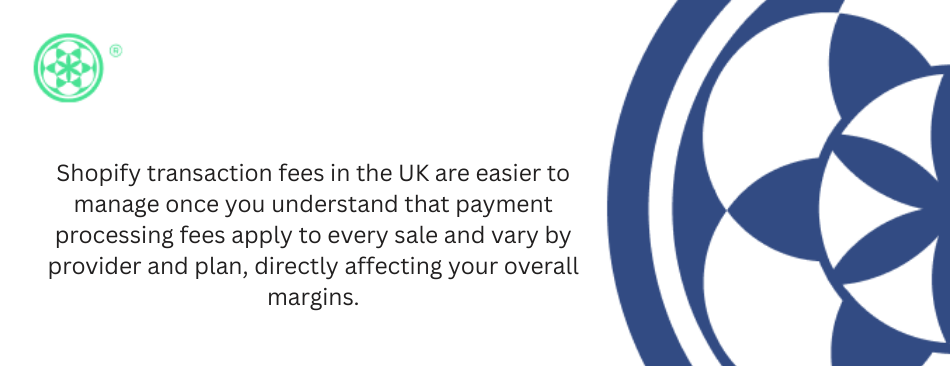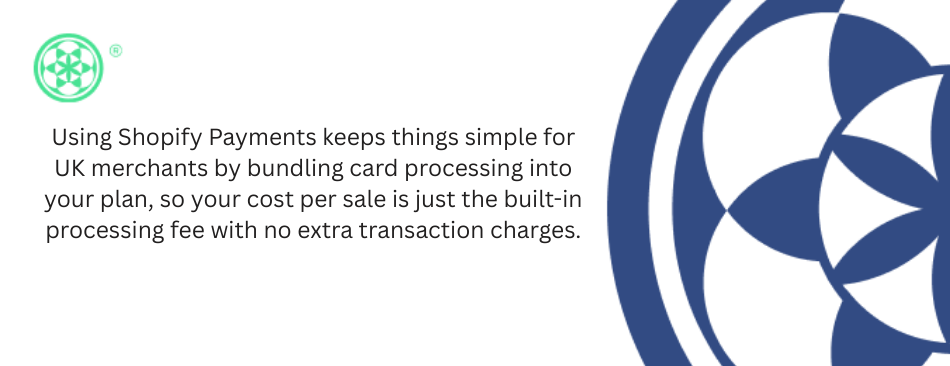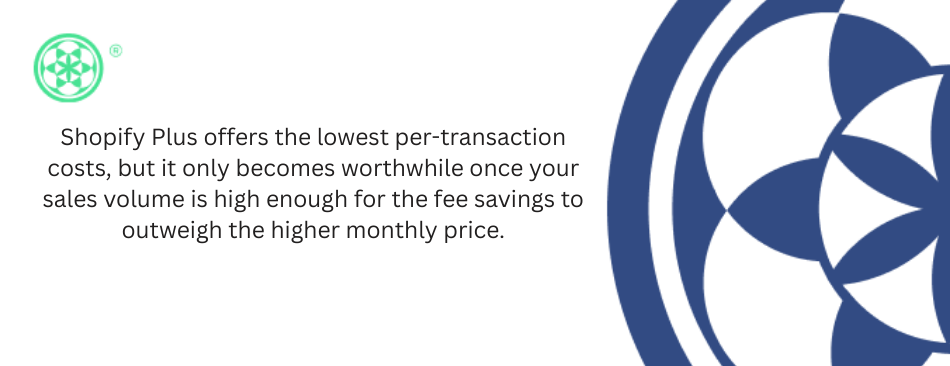Blog posts
Shopify Transaction Fees UK: Full Guide To Costs, Processing Rates, And How To Reduce Them
TLDR: What Are Shopify Transaction Fees In The UK?
Shopify transaction fees in the UK are the costs you pay when a customer completes a purchase on your store. There are two main charges to be aware of. First are payment processing fees, which come from providers like Shopify Payments, PayPal, or Stripe. Second are Shopify’s own transaction fees, which only apply if you choose not to use Shopify Payments.
For most UK merchants, the simplest way to lower overall Shopify transaction fees is to activate Shopify Payments, pick a plan that matches your monthly sales volume, and keep a close eye on pricing and fulfilment costs so your profit margins stay in good shape.
Key Takeaways
- Shopify Payments removes additional Shopify transaction fees, but payment processing charges still apply.
- Third-party gateways like PayPal and Stripe add both their own transaction fees plus Shopify’s extra fee (0.5–2%).
- Shopify Plus offers the lowest fee structure for high-volume brands, while Starter and Basic have the highest fee ratios.
- You can reduce total Shopify fees with better pricing, fulfilment optimisation, and using a single primary gateway.
- To stay profitable, calculate fees per product, not per order, so your pricing covers processing costs consistently.
What Are Shopify Transaction Fees In The UK?
Shopify transaction fees in the UK are made up of two separate layers, and understanding how they work together is key to keeping your costs under control.
The first layer is payment processing fees. These are charged every time a customer pays by card or digital wallet. The fee is taken by the payment provider handling the transaction, such as Shopify Payments, PayPal, or Stripe.
In the UK, these fees are typically a percentage of the order value plus a small fixed amount per transaction. The exact rate depends on your Shopify plan, with higher plans offering lower processing fees per sale.
The second layer is additional Shopify transaction fees. These only apply if you choose not to use Shopify Payments and instead rely on a third-party payment gateway.
Shopify adds a percentage fee on top of the payment processor’s own charges. This means you are effectively paying twice for the same transaction, once to the gateway and once to Shopify.
Processing fees decrease as you move up Shopify plans. Entry-level plans have the highest rates, while Advanced Shopify and Shopify Plus offer noticeably lower costs per transaction. For stores with consistent sales volume, upgrading plans can reduce total fees even if the monthly subscription is higher.
Using external gateways like PayPal or Stripe often increases overall costs. You still pay their processing fees, and if Shopify Payments is not enabled, Shopify’s additional transaction fee is added on top.
For most UK businesses, this makes Shopify Payments the most cost-effective option for card payments, while external gateways are best kept as secondary options for customer convenience rather than primary checkout methods.

Shopify UK Transaction Fees By Plan
Note: Exact rates can vary with industry and region; always verify inside your Shopify Payments settings.
How Shopify Payments Transaction Fees Work
Shopify Payments is designed to simplify how transaction fees work for UK merchants. When you use Shopify Payments, card processing fees are already built into your Shopify plan. This means you do not pay any additional Shopify transaction fee on top of the card rate.
Your total cost per sale is simply the processing fee associated with your plan and the payment method your customer uses.
The exact card rate depends on your plan level. Lower-tier plans have slightly higher processing fees, while higher-tier plans offer reduced rates per transaction. As your sales grow, these lower rates can make a noticeable difference to your margins, even if your monthly subscription cost increases.
If you choose to use an external payment gateway such as PayPal, Stripe, or Klarna as your primary processor, Shopify’s own transaction fee comes back into play. In that case, you pay the gateway’s processing fee and an additional Shopify transaction fee on top.
This stacking of fees is why many UK store owners keep external gateways enabled for customer choice but rely on Shopify Payments for the majority of card transactions.

How Do Shopify Fees Compare To Other Platforms?
Shopify transaction fees in the UK are generally competitive when compared with other ecommerce platforms, but the structure is different.
With Shopify Payments enabled, you only pay the card processing rate tied to your plan, which puts Shopify broadly in line with providers like Stripe and PayPal for standard card transactions.
Stripe can sometimes offer a slightly lower per-transaction rate, particularly for higher volumes. However, when Stripe or PayPal is used on a Shopify store without Shopify Payments, Shopify adds its own transaction fee on top. This often makes the total cost higher than it first appears, especially for stores processing frequent or high-value orders.
Platforms such as WooCommerce and BigCommerce take a different approach. They do not charge an additional platform-level transaction fee and rely entirely on third-party payment processors.
This can be cheaper for some merchants, particularly those already negotiating custom rates with Stripe or PayPal. For others, costs can end up similar or higher once gateway fees, plugin costs, and payment setup are factored in.
In practice, Shopify Payments offers predictable pricing and fewer moving parts, which many UK businesses prefer for budgeting and reporting. Other platforms may reduce per-transaction costs at scale, but they often require more hands-on payment configuration and ongoing fee monitoring.
How Much Does Shopify Take From A £100 Sale?
How To Reduce Shopify Transaction Fees
The only direct way to avoid Shopify’s additional transaction fees in the UK is to activate Shopify Payments.
Once Shopify Payments is enabled, Shopify does not charge its extra transaction fee, and you only pay the card processing rate linked to your plan.
Beyond that, there are several practical ways to reduce how much transaction fees affect your business overall.
- Choose the right Shopify plan for your sales volume
If your store is growing, moving to a higher plan can lower your per-transaction processing fees. Even though the monthly subscription is higher, the reduced card rates can offset that cost once you reach consistent order volume. - Use one primary payment gateway
Keeping most transactions flowing through a single gateway, ideally Shopify Payments, helps reduce blended fees. Too many gateways can increase average costs and make reporting harder to track. - Increase average order value
Fixed per-transaction charges hurt most on small orders. Bundles, upsells, and minimum order thresholds can raise average basket size and reduce the relative impact of processing fees on each sale. - Lower operational costs through fulfilment optimisation
Working with fulfilment partners that offer predictable storage, pick and pack, and shipping rates helps protect margins. When fulfilment costs are under control, transaction fees become a smaller percentage of each order rather than a constant pressure point. - Build small fee buffers into pricing
Some UK merchants quietly factor a small portion of payment fees into product pricing. When done carefully, this spreads costs across orders without noticeably affecting conversion or customer trust.
Reducing Shopify transaction fees is rarely about a single switch. It usually comes from aligning your payment setup, plan level, pricing strategy, and fulfilment model so fees stay predictable as your store scales.
Optimise your fulfilment costs with Bezos.ai
Shopify Fees Calculator (Simple Formula)
A simple way to stay profitable is to calculate Shopify transaction fees at product level rather than guessing. This makes pricing decisions clearer and helps you avoid margin surprises as volume grows.
Total fee per order formula
Total Fee Per Order = Processing Fee + (Order Value × Gateway Percentage Fee) + Additional Shopify Transaction Fee if applicable
If you are using Shopify Payments, the additional Shopify transaction fee does not apply, so the formula becomes much simpler and more predictable.
Reverse engineering your pricing
To make sure each product is priced correctly, work backwards from your costs:
Minimum Price = Cost of Goods + Fulfilment Cost + Shopify Fees + Desired Profit
This approach is especially useful for UK stores with varied product weights, shipping zones, or multiple payment methods, where fees can change slightly from order to order.
Many merchants build a simple spreadsheet that calculates fees per product or per order size. Others choose to integrate a Shopify transaction fees calculator directly into their reporting or pricing tools so margins are always visible without manual checks.
Is There A Fee For Using PayPal On Shopify?
Yes. Using PayPal on Shopify in the UK comes with its own costs. PayPal charges a processing fee on every transaction, which is separate from Shopify’s pricing. This fee is taken directly by PayPal and varies based on your account type, transaction volume, and whether the payment is domestic or international.
If Shopify Payments is not set as your default processor, Shopify also applies its additional transaction fee on top of PayPal’s charge. This means the total cost of a PayPal order can be higher than a standard card payment processed through Shopify Payments.
Beyond standard fees, PayPal-related factors can affect your overall cost structure. Currency conversion fees apply when customers pay in a different currency, and disputes or chargebacks may carry extra charges or temporarily hold funds.
For many UK merchants, PayPal works best as a secondary checkout option that improves customer trust and conversion, rather than the primary payment method used for most transactions.
Which Shopify Plan Has The Lowest Fees?
Shopify Plus has the lowest processing and transaction fees across all Shopify plans. Card rates are lower than on standard plans, and there are no additional Shopify transaction fees when Shopify Payments is used.
That said, Shopify Plus is built for high-volume or enterprise brands, and its monthly cost only makes sense once transaction savings clearly outweigh the higher subscription fee.
For most small and mid-sized UK businesses, the standard Shopify plan usually offers the best balance between monthly cost and transaction fees. It provides lower processing rates than entry-level plans without the steep jump in fixed costs that comes with Shopify Plus.
This makes it the most cost-effective option for stores that are scaling steadily but are not yet operating at enterprise volume.

Are Shopify Transaction Fees Worth It?
For most UK ecommerce brands, Shopify transaction fees are worth it. While the fee structure can look complex at first, it supports a platform that is fast, secure, and built to convert.
Shopify’s checkout is highly optimised, updates automatically, and handles compliance and security in the background. This all reduces technical risk for growing stores.
The value becomes clearer when fees are viewed alongside what Shopify removes from your workload. Native integrations, reliable reporting, and automation across payments, inventory, and order management help reduce manual tasks and operational friction.
When Shopify is paired with third-party fulfilment services like Bezos.ai, brands can also streamline storage, pick and pack, and shipping across the UK and Europe, keeping delivery times competitive and margins under control.
In practice, most UK merchants find that Shopify’s transaction fees are offset by higher conversion rates, smoother operations, and easier scaling. Rather than being a cost to avoid at all costs, the fees often function as part of a wider system that supports growth without constant technical intervention.
Reduce logistics and shipping overhead to offset Shopify fees
Conclusion
Shopify transaction fees in the UK are made up of card processing charges and, in some cases, additional fees when third-party payment gateways are used. The quickest way to control these costs is to enable Shopify Payments and select a plan that matches your revenue and order volume.
Once transaction fees are optimised, fulfilment becomes the biggest driver of profitability. Lower shipping costs, smoother operations, and reliable delivery performance usually create far more margin flexibility than switching payment gateways alone. UK brands that pair Shopify Payments with efficient fulfilment partners tend to see the most meaningful reductions in total operating costs while maintaining a strong customer experience.
FAQ
What are Shopify’s transaction fees?
They are charges applied to each sale, made up of card processing fees and an additional Shopify fee if you use an external payment gateway.
How can I reduce Shopify transaction fees?
Enable Shopify Payments, move to a higher plan as volume grows, and optimise fulfilment and pricing to protect margins.
Are transaction fees waived with Shopify Payments?
Yes. Shopify’s extra percentage fee is removed when Shopify Payments is active, though standard processing fees still apply.
How do Shopify fees compare to other platforms?
They are generally competitive, particularly when using Shopify Payments. Costs increase when external gateways are added.
Is there a fee for using PayPal on Shopify?
Yes. PayPal charges its own processing fee, and Shopify applies an extra fee if PayPal is not your primary gateway.
Which Shopify plan has the lowest fees?
Shopify Plus has the lowest fees overall, followed by Advanced Shopify.
How are transaction fees calculated on Shopify?
Processing fee plus the gateway percentage, with an additional Shopify fee if a third-party gateway is used.
Can I avoid fees by choosing a specific payment gateway?
No. Only Shopify Payments removes the additional Shopify fee. Other gateways include their own charges and Shopify’s fee.
Are Shopify transaction fees worth the cost?
Usually yes, due to Shopify’s strong checkout performance, reliability, and ability to scale.
What hidden charges should I know about?
Currency conversion fees, third-party gateway fees, chargeback costs, and cross-border processing charges.
What is the cheapest way to reduce Shopify transaction fees for my online store?
Activate Shopify Payments and reduce fulfilment overhead by working with efficient partners such as Bezos.ai.
How can I calculate total Shopify transaction fees to set profitable prices?
Use the pricing formula outlined above or integrate a transaction fee calculator into your store.
How do Shopify transaction fees work with Shopify Payments versus third-party gateways?
Shopify Payments removes the extra Shopify fee, while third-party gateways add additional percentage charges.
How much will Shopify transaction fees cost per month based on sales volume?
Multiply your average order value by your monthly order count, then apply your processing and gateway rates.
Which Shopify plan gives the lowest combined fees for international sales?
Shopify Plus offers the strongest flexibility and negotiation options for global brands.
Can I pass Shopify fees into product pricing?
Yes. Many brands adjust pricing slightly to absorb fees without hurting conversion rates.
As a part of the Bezos.ai team, I help e-commerce brands strengthen their fulfilment operations across the UK, Germany, the Netherlands and the US. I work with merchants that want to simplify logistics, reduce costs and expand into new markets. I’m also building my own e-commerce brand, which gives me practical insight into the challenges founders face. In my writing, I share fulfilment strategies, growth lessons and real-world advice drawn from both sides of the industry.












